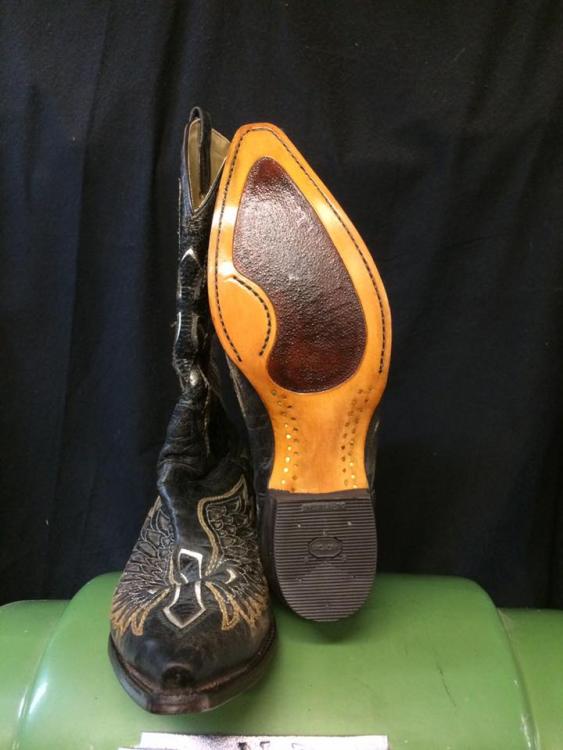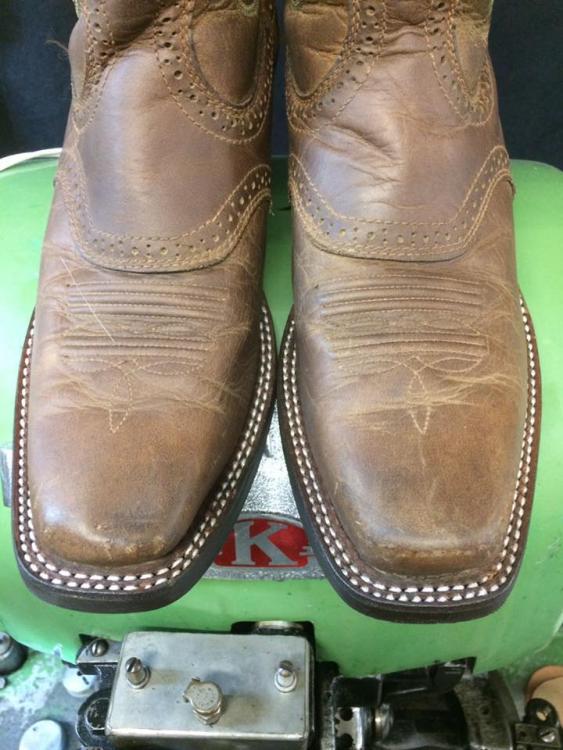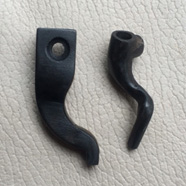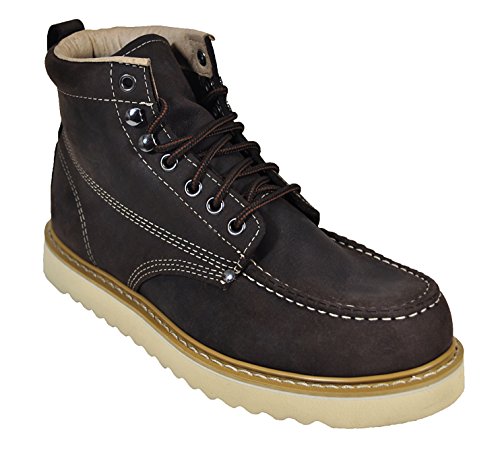-
Posts
518 -
Joined
-
Last visited
Content Type
Profiles
Forums
Events
Blogs
Gallery
Posts posted by Singermania
-
-
You also have a lot of white crap coming off the thread... starting right at the top (secondary) tension unit, if that is normal for this kind of thread then 'ok', but if not it indicates to me the top thread is under considerable strain. I have eight or so 7 class Singers and a few even bigger Adler, but don't recall any of them doing that. With regards to rotation off the bobbin, I find it can go either way and is not critical. Lastly you are sewing tight weave webbing, this stuff sticks to or closes up around the long left groove in the needle not allowing the thread to hide in there...(yes technical speak), try going up a needle size to increase the size of that groove.
Look forward to hearing your results.
-
What is it you wish to know about the machine? Either Darren Brosowski or I can probably help.
-
-
top left are the prickers, and bottom left are the needle steadies. Darren I have rein rounder attachments if you want to see them..
-
When these type of problems occur its a good idea to swap the thread for a completely different brand or type, replace the needle. Some machines simply don't like some threads. Also both of your top tension units are wound up tight, I'd back them right off and try again. Overtight on top will drop stitches.
-
The Singer 16 class is an excellent machine, yours is the kick foot/walking foot version. Forget the manual, its nice to own but wont tell you much, they are pretty much all the same. This is a good machine for light leather work such as wallets and handbags.
-
-
-
I think you should sell things you don't need, keep the guitar it will be a friend for life.
-
The Singer list is good and most people know about it, but most of the machine manuals people are looking for are not on that list, that is why they are writing and enquiring. If you need manuals then I sent out what I have free of charge via email.... I have the 132K6 series, 133K8 series, 45k flatbed and cylinder arm, Adler 20 series, Champion, Pearons no 6 and A1 and so on.
Don't be afraid to ask, I send out on average about 5 manuals per week.
-
HI, Yes I have tried over the years to get all the manuals for the heavy machine and do have the German version of the Adler 20 manual.
I tried to load it here but seems to be too big. If you let me have your email address I'll send it to you that way.
Best Regards Steve
-
Didn't the Old-timers call the -64 needle-feed style a "jump foot" machine?
CD in Oklahoma
Don't think so, the Singer 132K6 was loosely called a walking foot machine but was actually a jump foot, ie the foot would follow the material back thru friction and then lift and jump forward via spring and drop down again on the material. Not strictly a walking foot as it didn't actually mechanically feed the material, but did reduce top drag.
-
Needle wise, the last one I had was set up with a 214/216 (singer 45K, 132K6) needle.
-
My recollection is that the -64 is the needle feed version, but others will know more and will confirm either way. A very good machine!!
-
Same basic machine, there are special feet as you say, then a special cutting/grooving feed dog and a modified needle plate. You would also use the D point leather needle.\ No alterations were necessary on the 4500 itself, so it can easily still be used for saddlery and shoe uppers..... by a quick change back to standard kit. A few people have asked whether it can perform shoe patcher work, however this would not be possible, just a wish too far.
I would like to hear what other jobs might be useful in the shoe trade that we could look at next.
-
HI all, we (Cowboy Leather Machines Australia) have been working for some time on a new machine to fill a spot in the market dominated for many years by the Landis 12. The machine was to be able to sew shoe uppers onto soles in the outsole stitching fashion.
We are now pleased to be able to offer the Cowboy CB4500 Outsole Stitcher. The advantage of this machine is that it is also capable of saddlery and sewing shoe uppers as well. In other words its many machines in one. The shoe industry has not been Cowboy Leather Machines of Australia's main market and we are only just moving into it, with sales of the new machines going well. I would like at this time to ask the opinion of other shoe fanciers whether they feel this machine could also fill other requirements and if so what would they be?
The machine comes with a specially designed foot, plate and dog set to allow it to sew out soles and imbed the stitching on the bottom.
-
All of the above suggestions seem on the money to me, if after that you are still having some problems I'd go one larger in the needle to a 250/27. Threads and needles can vary as well as machines, sometimes the thread is just too thick (no matter what its designated size or gauge) to fit in the long groove of the needle comfortably while sewing and can result in tangles and dropped stitches.
-
Wiz did pretty well to get one for $700, I'd have thought even the basic model would be worth more. But to sell it you'll need to indicate its model number, that will then tell people for example, if its a needle feed machine or perhaps a compound feed model.
-
UPDATE. Cowboy CB4500 Outsole Stitcher. Cowboy Leather Machines has been working on for some time an outsole stitcher based on the Cowboy CB4500. This new machine can competently sew around the shoe upper and thru the sole, nice and in close and perform outsole stitching duties. With this new machine we are looking at building serious inroads into the shoe markets.
-
You're right Art, its Winter here, but up in Queensland its usually shorts and t shirts all year round, so long pants and socks is cold for us..
-
Like I said, you were bound to get some serious technical advice. Trying to work out deflection from a given centre force is a bit serious, not withstanding that all A or V belts are not created equal and will flex or stretch a bit differently. Really its simple enough, if its too loose it will slip, if its too tight it will bind up the machine and the belt will practically ping if you flick it with your finger. Its a wet rainy day here and am catching up on some leisure time, hope everyone out there is also having a good Sunday.
-
Yes the old slide test is a good one, used to be in all the Singer operator manuals. I also find that if when you go to thread your needle if its hard to get the thread thru its too thick, or if it just flops straight thru without seemingly even touching the side of the needle hole then its too thin.. There are times when you might want on oversize needle to thread relationship though, like sewing thick leather or sticky vinyl where you need the hole a bit bigger to give the the machine a chance to lock the stitch.....
-
No, once you put a speed reducer into the equation the gearing, friction and inertia are working against you and it does become a bit more difficult to turn, however (depending on how strong your are) it should still be able to get rolling.... again when its too tight it will be really hard to turn over. We find on the box style reducer that the first thing to slip is the small reducer pulley as it doesn't seem to have the depth of other pulley wheels.
-
Ok sounds like you have it solved, my point about warranty and dealers is that its best to ask the dealer before making mods, a typical line in a warranty document outlining things NOT covered would be.... 3) The machine fault results from dismantling, repairing and assembling of the product without the authorization of the Company. Obviously its your machine and you can do whatever you want, however if it went belly up at some later stage and your dealer wanted to be difficult or was under financial strain might see it as a way of getting out of the warranty agreement.
Whilst there are people on this and other sights with a lot of knowledge they should think twice about giving advice to people to make modifications to new machines without the ok from either the manufacturer or the dealer. Maybe its a bit like putting an unapproved performance chip in your car or truck and then finding the dealer is wanting to get out of covering your blown engine.










Singer 7-33 Stitching problem & parts
in Leather Sewing Machines
Posted
Yes I understand what you mean about getting it right, with leatherwork there can be no compromise !!